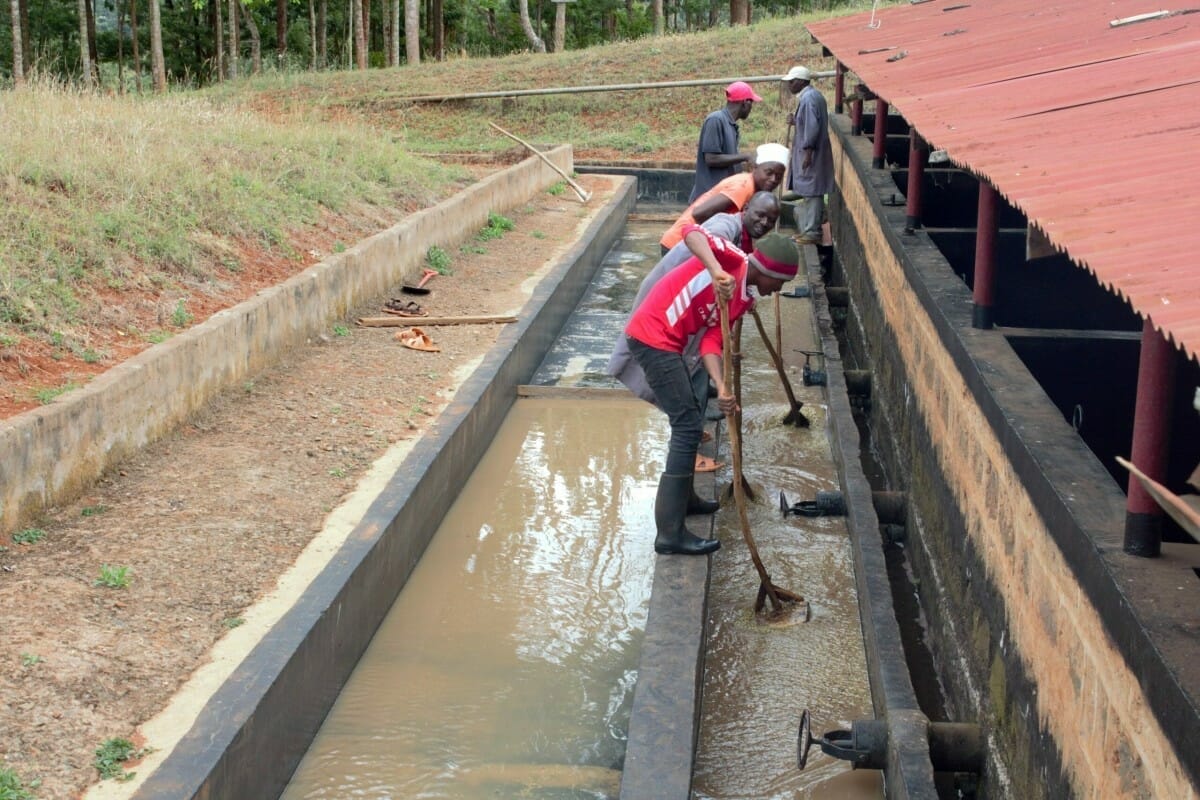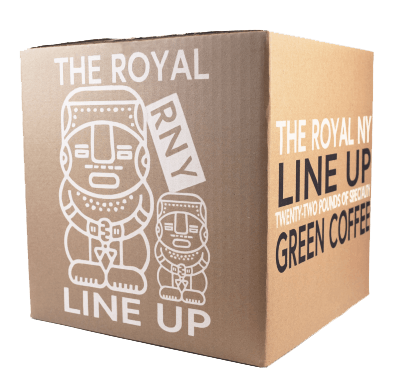No products in the cart.

Origin Profile: Kenya
Coffees from Kenya are vibrant, complex, and offer some of the most unique flavor profiles: from blackberry and currant to tomato.
| Harvest: | Varies Regionally |
| Arrival: | December - June |
| Number of Producers: | ~800,000 |
| Average Farm Size: | <1 Hectare |
| Annual Production: | 650 Thousand 60-Kilo Bags |
| Common Varieties | SL-28, SL-34, Ruiru-11, Batian, K7 |
| Grades: | AA - scr. 17/18 AB - scr. 15/16 PB - Rounded mutation ~scr. 12 |
| Central Region | Thika, Kirinyaga, Nyeri, Kiamu, and Murang’a produce complex coffee with vibrant acidity on the slopes of Mt. Kenya and the Aberdare mountains |
| Eastern Region | Embu, Meru, and Machakos are more arid. They produce a more mild coffee on lower-lying hills |
| Western Region | Bungoma, Vihika, Kakamega produce coffee on the slopes of Mt. Elgon. The coffee is complex and high in acidity |
| Rift Valley | Nandi, Nakuru, Baringo produces more mild coffee in young volcanic soils at lower elevations |
| Data Based on MY2019/2020 | |
Coffee was first planted in Bura in the coastal Taita Hills in 1893. It spread slowly through the turn of the century only in European controlled areas of the country. Native Kenyans were forbidden from planting coffee, but young European aristocrats with more than 1,000 pounds were given 1,000 acres to establish plantations. In the 1930s, various legislation was enacted to stimulate the industry including allowing native Kenyans to plant coffee, but the farms were limited to 100 trees on 1/4 acre of land far from the European estates to limit their competition. Trade was difficult through small, relatively unorganized institutions and the local growers in more forced into remote areas did not have the benefit of solid infrastructure to transport and sell their coffee. The Coffee Board was established in 1933 to oversee licensing, inspection, and promotion. The Kenya Coffee Auction was inaugurated in 1935 and has been the primary method of coffee purchasing to date.
Smallholders were required to join cooperatives in 1944 and the cooperatives operated under the purview of the coffee board. Since the Board was primarily run by the large estate owners, legislation was less favorable to cooperatives making it difficult for them to compete.
Kenya formed an independent government in 1963 after the Mau Mau Uprising, a brutal conflict between the British Authorities and the Mau Mau. The Mau Mau, officially known as the Kenya Land and Freedom Army, was comprised primarily of the Kikuyu, Meru, and Embu people, but included some Kamba and Maasai people as well.
The Coffee Development Authority was enacted in 1964 by the newly liberated nation to provide small farmers and cooperatives access to better information, technology, and financial resources. The new policies also involved the redistribution of some estate lands to native Kenyans. Over the 1965-2005 period, smallholder coffee lands increased from 13,00ha to 128,000ha. During this same period, the area covered by estates also increased, but at a much slower rate from 32,000ha to 42,000ha.
Kenya joined the International Coffee Agreement in 1962. The ICA helped to maintain relatively high prices to strengthen the economies of coffee producing countries by assigning quotas to member countries. Since the dissolution of the ICA quota system in 1989, Kenya’s coffee production has continued to decline as the impacts of global climate change impact yields and the crop becomes decreasingly profitable against coffee from Brazil and Colombia.
Small holder farmers (<2ha) are still required to sell cherry to cooperatives who will process it into parchment coffee at factories. Most farmers will produce less than one bag of coffee per year, so processing the coffee themselves is not worthwhile. Cooperatives will deliver the parchment to a relatively small number of mills which will produce green coffee. From there, it will be transported to warehouses where samples will be taken to the Auction for grading before bidding. A majority of the coffee in Kenya is sold this way, but there is a limited number that is sold through the Second Window.
The Second Window allows for direct purchase of coffee by overseas buyers. Most small growers do not have the capacity to market their own coffee outside of the exchange so they rely on a relatively few number of commercial marketing agents. Larger estates are more capable to market their coffee overseas and have had greater success, but since they also have greater marketing power at the exchanges, there is little incentive to pursue the Second Window. Direct sales are continuing to grow and now account for about 15-20% of sales.
The large number of actors in the supply stream drives price of Kenyan coffee higher. Even though the Coffee Directorate requires farmers to be paid 80% of the final sale price of their coffee, that is rarely the case. The average auction price was 4.07USD per kg in 2017/18. The highest payment rate to farmers according to the ICO was found in Nyeri at 105 KES or 0.98USD per kg, less than 20% of the auction’s average sale price that year. The other counties’ payment rates were even lower.
Scott Agricultural Laboratories was established by the British Colonial government in 1922. The coffee section of the Department of Agriculture was moved to the labs in 1934 and over the next 5 years, 42 trees of various origins were planted and studied at the 24 acre site. Each of these plants was labeled with” SL-#.” The labs conducted a variety of experiments in collaboration with private estate owners in the region to test the resilience, yield, and quality of the coffee. In 1944 the Department of Agriculture relocated the coffee section to an estate better suited for field experiments ending the use of Scott Labs. The Department of Agriculture for Kenya created the Kenya Agriculture Research Institute (KARI) in 1979 bringing together research institutions to improve food crops, tea and coffee production, rangelands management, and livestock production. In 2013, KARI was replaced by KALRO, the Kenya Agriculture and Livestock Research Organization. Today, KALRO oversees the Coffee Research Institute (CRI) of Kenya.
Kenya continues to struggle against climate change and urbanization. Climate change is creating shorter, less predictable rainy seasons and drought in some areas of the country. This is causing decreased yields and less certain quality. Many farmers are looking to produce different crops or to raise livestock for a more reliable income. As more people relocate to the cities, land is becoming increasingly more expensive in the primary coffee growing regions surrounding Nairobi. As coffee becomes increasingly more difficult to grow, farmers may opt to sell their land to developers.
Smallholders were required to join cooperatives in 1944 and the cooperatives operated under the purview of the coffee board. Since the Board was primarily run by the large estate owners, legislation was less favorable to cooperatives making it difficult for them to compete.
Kenya formed an independent government in 1963 after the Mau Mau Uprising, a brutal conflict between the British Authorities and the Mau Mau. The Mau Mau, officially known as the Kenya Land and Freedom Army, was comprised primarily of the Kikuyu, Meru, and Embu people, but included some Kamba and Maasai people as well.
The Coffee Development Authority was enacted in 1964 by the newly liberated nation to provide small farmers and cooperatives access to better information, technology, and financial resources. The new policies also involved the redistribution of some estate lands to native Kenyans. Over the 1965-2005 period, smallholder coffee lands increased from 13,00ha to 128,000ha. During this same period, the area covered by estates also increased, but at a much slower rate from 32,000ha to 42,000ha.
Kenya joined the International Coffee Agreement in 1962. The ICA helped to maintain relatively high prices to strengthen the economies of coffee producing countries by assigning quotas to member countries. Since the dissolution of the ICA quota system in 1989, Kenya’s coffee production has continued to decline as the impacts of global climate change impact yields and the crop becomes decreasingly profitable against coffee from Brazil and Colombia.
Small holder farmers (<2ha) are still required to sell cherry to cooperatives who will process it into parchment coffee at factories. Most farmers will produce less than one bag of coffee per year, so processing the coffee themselves is not worthwhile. Cooperatives will deliver the parchment to a relatively small number of mills which will produce green coffee. From there, it will be transported to warehouses where samples will be taken to the Auction for grading before bidding. A majority of the coffee in Kenya is sold this way, but there is a limited number that is sold through the Second Window.
The Second Window allows for direct purchase of coffee by overseas buyers. Most small growers do not have the capacity to market their own coffee outside of the exchange so they rely on a relatively few number of commercial marketing agents. Larger estates are more capable to market their coffee overseas and have had greater success, but since they also have greater marketing power at the exchanges, there is little incentive to pursue the Second Window. Direct sales are continuing to grow and now account for about 15-20% of sales.
The large number of actors in the supply stream drives price of Kenyan coffee higher. Even though the Coffee Directorate requires farmers to be paid 80% of the final sale price of their coffee, that is rarely the case. The average auction price was 4.07USD per kg in 2017/18. The highest payment rate to farmers according to the ICO was found in Nyeri at 105 KES or 0.98USD per kg, less than 20% of the auction’s average sale price that year. The other counties’ payment rates were even lower.
Scott Agricultural Laboratories was established by the British Colonial government in 1922. The coffee section of the Department of Agriculture was moved to the labs in 1934 and over the next 5 years, 42 trees of various origins were planted and studied at the 24 acre site. Each of these plants was labeled with” SL-#.” The labs conducted a variety of experiments in collaboration with private estate owners in the region to test the resilience, yield, and quality of the coffee. In 1944 the Department of Agriculture relocated the coffee section to an estate better suited for field experiments ending the use of Scott Labs. The Department of Agriculture for Kenya created the Kenya Agriculture Research Institute (KARI) in 1979 bringing together research institutions to improve food crops, tea and coffee production, rangelands management, and livestock production. In 2013, KARI was replaced by KALRO, the Kenya Agriculture and Livestock Research Organization. Today, KALRO oversees the Coffee Research Institute (CRI) of Kenya.
Kenya continues to struggle against climate change and urbanization. Climate change is creating shorter, less predictable rainy seasons and drought in some areas of the country. This is causing decreased yields and less certain quality. Many farmers are looking to produce different crops or to raise livestock for a more reliable income. As more people relocate to the cities, land is becoming increasingly more expensive in the primary coffee growing regions surrounding Nairobi. As coffee becomes increasingly more difficult to grow, farmers may opt to sell their land to developers.




